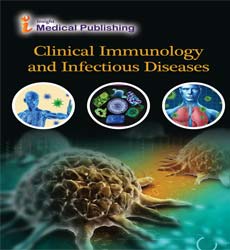Maladaptive Immune Responses in Emerging Infectious Diseases: Mechanisms, Consequences, and Therapeutic Insights
Sandrea Marval*
Department of Immunology, the University of Texas MD Anderson Cancer Center, USA
*Corresponding author:
Sandrea Marval,
Department of Immunology, The University of Texas MD Anderson Cancer Center, USA,
E-mail: sandrea@marval.edu
Received date: January 01, 2025, Manuscript No. Ipciid-25-20580; Editor assigned date: January 03, 2025, PreQC No. Ipciid-25-20580 (PQ); Reviewed date: January 15, 2025, QC No. Ipciid-25-20580; Revised date: January 22, 2025, Manuscript No. Ipciid-25-20580 (R); Published date: January 28, 2025, DOI: 10.36648/.9.1.5
Citation: Ferda N (2025) Immune Dysregulation in Emerging Pathogens: Consequences and Interventions. Clin Immunol Infect DisVol.9 No.1:5
Introduction
Maladaptive immune responses are a defining feature of many emerging infectious diseases, where the severity and long-term consequences of infection often stem more from host immune activity than from the pathogen itself. Deciphering how innate and adaptive immunity become dysregulated during novel infections is critical for developing precise diagnostics, targeted therapies, and effective public-health strategies [1].
Description
Innate immune dysregulation frequently initiates disease pathology through impaired pattern-recognition signaling, delayed or excessive type I/III interferon responses, or failure to produce timely antiviral signals. When insufficient, these defects allow rampant pathogen replication; when excessive, they trigger hyperinflammatory states marked by neutrophil extracellular trap formation, complement activation and cytokine release from monocytes and macrophages, leading to tissue damage [2].
Adaptive immunity can further amplify pathology: delayed, narrow, or exhausted T-cell responses reduce viral clearance and promote chronic infection, while dysregulated B-cell responses generate non-neutralizing antibodies or pathogenic immune complexes. Many pathogens actively exploit these vulnerabilities through immune evasion proteins, antigenic variation, superantigen-like stimulation, or induction of regulatory and autoimmunity triggered by molecular mimicry or bystander activation pathways; tipping the immune system into harmful, maladaptive responses The consequences of immune dysregulation include cytokine storm syndromes, endothelial activation with coagulopathy These mechanisms account for multi-organ involvement, thrombotic events and persistent post-infectious syndromes observed in severe influenza Ebola, and other emerging viral infections [3].
Host-specific factors such as age, comorbidities, and genetic polymorphisms in immune-related genes, baseline inflammatory state, and microbiome composition further modulate susceptibility and clinical heterogeneity. Therapeutically, interventions ranging from corticosteroids and cytokine inhibitors to immunomodulatory antivirals and passive antibody therapies require precise timing and patient-specific targeting Early interventions that limit viral replication such as antivirals or monoclonal antibodies can prevent downstream maladaptive immune cascades, while population-level determinants, including nutrition, co-infections, and vaccine coverage, influence community-wide vulnerability [4]
Suppressing inflammation prematurely can impede pathogen clearance, while delayed intervention may fail to prevent irreversible tissue injury, influence susceptibility, disease severity, and vaccine responsiveness. These insights guide precision medicine approaches that tailor immunotherapies and vaccination strategies to individual immune profiles, aiming to maximize protection while minimizing immunopathology from a public-health and systems perspective, immune dysregulation shapes disease surveillance, vaccine development, and long-term patient management Biomarkers distinguishing protective versus pathological immune states can guide triage and individualized therapy [5].
Conclusion
Overall, dysregulated immune responses are both a mechanistic driver and a clinical hurdle in emerging infectious diseases. Understanding the complex interplay between pathogen strategies and host immune pathways enables precision interventions that achieve effective pathogen control while minimizing immune-mediated harm, ultimately improving individual outcomes and strengthening population resilience.
Acknowledgement
None.
Conflict of Interest
None.
References
- Banchereau R, Hong S, Cantarel B, Baldwin N, Baisch J, et al. (2016) Personalized Immunomonitoring Uncovers Molecular Networks That Stratify Lupus Patients. Cell 165: 551–565
Google Scholar Cross Ref Indexed at
- Becker JT, Olson BM, Johnson LE, Davies JG, Dunphy EJ, et al. (2010) DNA Vaccine Encoding Prostatic Acid Phosphatase (PAP) Elicits Long-Term T-Cell Responses in Patients with Recurrent Prostate Cancer. J Immunother 33: 639–647
Google Scholar Cross Ref Indexed at
- Vohra J, Barbosa G, Pascoal LB, Reis LO (2025) Advances in Genitourinary Tumor Genomics and Immunotherapy. Genes 16: 667
Google Scholar Cross Ref Indexed at
- Sahin U, Derhovanessian E, Miller M, Kloke BP, Simon P, et al. (2017) Personalized RNA Mutanome Vaccines Mobilize Poly-Specific Therapeutic Immunity Against Cancer. Nature 547: 222–226
Google Scholar Cross Ref Indexed at
- Walter S, Weinschenk T, Stenzl A, Zdrojowy R, Pluzanska A, et al. (2012) Multipeptide Immune Response to Cancer Vaccine IMA901 After Single-Dose Cyclophosphamide Associates with Longer Patient Survival. Nat Med 18: 1254–1261
Open Access Journals
- Aquaculture & Veterinary Science
- Chemistry & Chemical Sciences
- Clinical Sciences
- Engineering
- General Science
- Genetics & Molecular Biology
- Health Care & Nursing
- Immunology & Microbiology
- Materials Science
- Mathematics & Physics
- Medical Sciences
- Neurology & Psychiatry
- Oncology & Cancer Science
- Pharmaceutical Sciences
